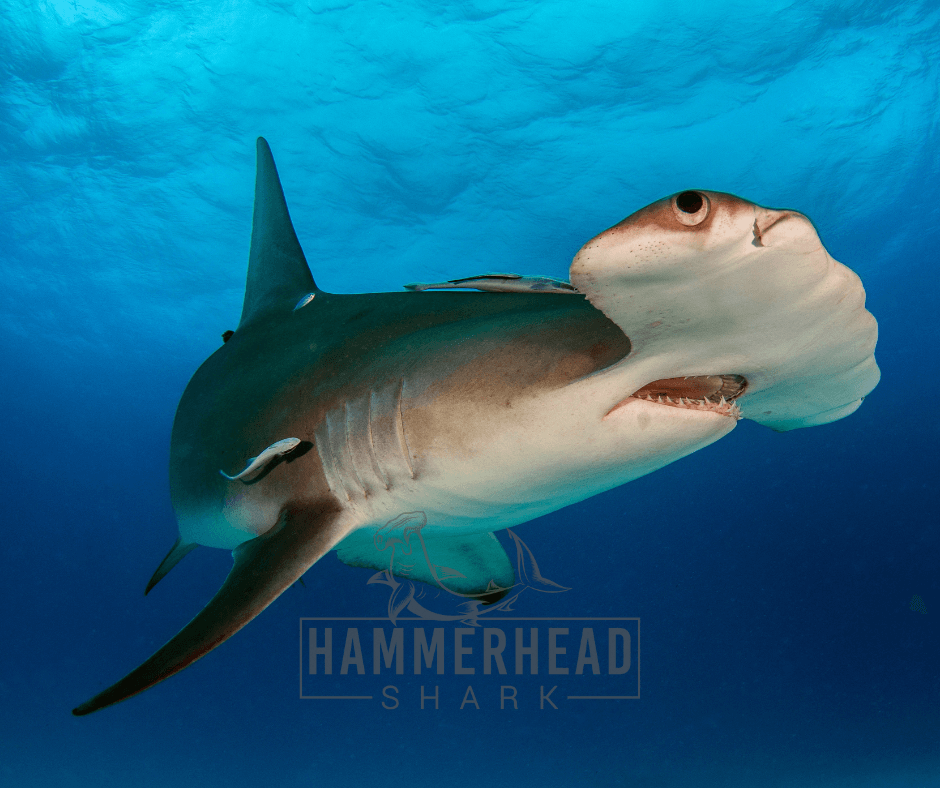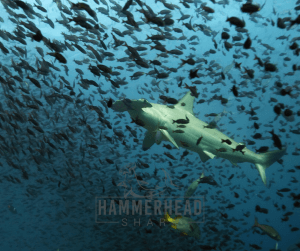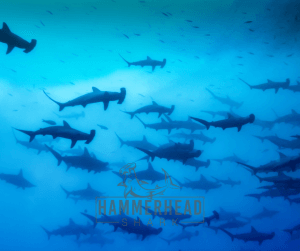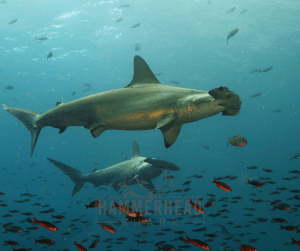Hammerheads are fascinating creatures of the sea world. Ten hammerhead sharks are known and well documented, the 10th species being a recent discovery.
Nine of them belong to the genus Sphyrna. Only the winghead shark has its genus, Eusphyra.

Great hammerhead shark – Sphyrna mokarran
The great hammerhead stands up to its name! It is the largest of the hammerhead sharks. They can grow to a maximum length of around six metres; the record stands at a staggering 6.6 meters. These are known to grow up to 4 meters.
Identified by its large hammer, or cephalofoil, it has a dent in the middle and a huge dorsal fin. Stingrays appear to be their favourites, though they eat a variety of other marine life, including fish and crustaceans.
Solitary swimmers are found worldwide in warm tropical waters. Known to visit coastal areas, they are found around coral reefs, atoll passes and lagoons and frequent far offshore.
Though they are not bottom dwellers, little is known about them or their migratory behaviour. They are known to have litters of up to 50 pups at a time.
Great hammerheads are uncovered both close to shore and offshore in warm temperate and tropical waters. They live in the Atlantic, Pacific, Indian Oceans, the Mediterranean, Black Seas, and the Arabian Gulf.
IUCN Status: Critically Endangered
Scalloped hammerhead shark (Sphyrna lewini)
It gets its name from the identifiable notches in the centre of its hammer, which resembles the shape of a scallop shell. The head has narrow blades, and this relatively large hammerhead shark can grow to four meters in length.
Scalloped hammerheads are even in bays and estuaries (in-shore) found in water about 900 274 meters deep.
Vast schools are dominated by mature females who patrol the sea mounts like Cocos and Malpelo in the Eastern Pacific during the day. At night, they disperse or form smaller groups to hunt. Smaller but more excellent schools are rising from cold water in the Red Sea.
Scalloped hammerhead schools are spotted riding the thermoclines in the Maldives, Indonesia, PNG and French Polynesia. These sharks sometimes venture into estuaries and are found in warm temperate and tropical waters across the globe.
Young scalloped hammerhead sharks use estuarine areas around Fiji in their early years. Considered ‘endangered’ throughout their global distribution, the recent discovery of these aggregation areas is essential in helping ensure the survival of these sharks.
IUCN Status: Critically Endangered
Smooth hammerhead shark (Sphyrna zygaena)
The smooth hammerhead gets its name as it doesn’t have an indentation in the centre of its hammer, thereby giving it a smooth appearance. They are the second-largest hammerhead shark after the great hammerhead, and mature females can be as long as 4 metres.
They feed on bony fishes, rays and even other sharks.
This species is more easy-going in calmer waters among the hammerheads. Found in temperate and warmer waters around the globe, they migrate to the poles during the summer to stay cool!
They stay closer to the ocean surface than scalloped and great hammerhead cousins and prefer to spend time in bays and estuaries. As a result, smooth hammerheads have been heavily overfished.
IUCN Status: Vulnerable
Winghead shark (Eusphyra blochii)
A small species of hammerhead, winghead sharks grow up to two metres in length.
It is notable for its vast hammer, as wide as 50 per cent of the shark’s length, giving the appearance of a wing, and hence the name winghead!
This small brown to grey shark has a slender body with a tall, sickle-shaped first dorsal fin. While the function of this structure is unclear, early research ties it to the shark’s senses.
A broad head means wide spacing of its eyes. It gives superb binocular vision.
The cephalofoil also provides a large surface area for its ampullae of Lorenzini and lateral line, equipping it with better detection and tracking of odour trails in the water via strong electroreception and mechano-reception.
They are found in tropical waters of the central and western Indo-Pacific and the Persian Gulf. They primarily feed on bony fishes.
Pregnant females are aggressive, known to fight each other, probably protecting their young ones. They have litters of up to 25 pups.
IUCN Status: Endangered
Bonnethead (Sphyrna tiburo)
A small and active hammerhead shark, Bonnethead has a distinctive rounded head unlike other hammerheads and is called the shovelhead. Males and females of this species have different shaped heads, an exclusive of this hammerhead species. The adult females have broad round heads, and males have a distinctive bulge in the middle of the hammer.
Since these sharks have a smaller hammer, they have to rely upon their large pectoral fins for swimming, making them the only species among hammerheads.
Also, they are among the only shark species known to display sexual dimorphism in the morphology of the head and are the only shark species known to be omnivorous.
Less than a meter long, they were plentiful on Pacific and Atlantic coasts, from Rhode Island to Brazil and California to Peru. Extensive overfishing has made them extremely rare across most of their habitat.
IUCN Status: Endangered
Scalloped Bonnethead (Sphyrna corona)
A rare shark, largely unknown, scalloped Bonnethead is also called the crown shark or mallet head shark. They have a typical rounded head, possibly giving them the “crown” shark name.
Found in the eastern Pacific Ocean, with a limited range from Mexico to Peru, these sharks spend their time in-shore, sometimes visiting estuaries and mangroves, and feed on fish and crustaceans.
Probably the smallest species of hammerhead shark, females grow up to nearly a metre in length, and the males are slightly smaller. The scalloped Bonnethead is viviparous, with only two pups per litter, born 23 cm in size.
Extensive artisanal and commercial fishing has devastated stocks in recent years.
IUCN Status: Critically Endangered
Scoophead (Sphyrna media)
Little-known species among the hammerheads, the scoophead, is found in tropical waters in the Western Atlantic and Eastern Pacific oceans.
It is slightly larger than the scalloped Bonnethead but looks similar. The scoophead shark has a shorter snout and a broad arched mouth.
Scoophead coexists with two other small hammerheads, the Bonnethead and the golden hammerhead. They appear to avoid competition by diet and habitat differences, feeding on small elasmobranchs, octopuses, squid, and flounders.
Scoophead, like other hammerheads, is viviparous and gives birth to pups measuring 34 cm or less at birth.
It is caught by fisheries throughout its range and has suffered from destroying its mangrove forest habitat.
IUCN Status: Critically Endangered
Smalleye hammerhead (Sphyrna tudes)
Smalleye hammerheads, called golden hammerheads, have a distinctive bright gold colour on their heads and body parts. It was only scientifically documented in the 1980s. They are also known as curry sharks.
Researchers say that the colouration comes from pigment in the shrimps that juvenile smallhead sharks eat and the sea catfish that adults eat. It is also learnt that this colour may help camouflage them in the muddy habitats they prefer, making it difficult for larger predators to find them.
Commonly found in the shallow coastal waters of the western Atlantic Ocean, from Venezuela to Uruguay, it favours muddy habitats with poor visibility, reflected by its relatively small eyes.
While adult males and juveniles are found in schools, adult females live in solitude. Typically reaching 1.2–1.3 metres in length, like in all hammerheads, its head is flattened and laterally expanded into a hammer-shaped structure which is wide and long with an arched front margin bearing central and lateral indentations.
They have litters of up to 19 pups each year.
Caught by fisheries throughout their limited area, their numbers are rapidly declining, making them vulnerable to extinction.
IUCN Status: Critically Endangered
Whitefin Hammerhead
One of the most intriguing sea creatures, the Whitefin Hammerhead Shark (Sphyrna couardi), is a majestic shark inhabiting our vast oceans. Among the large hammerheads that can reach a maximum length of more than 2.7 meters, whitefin hammerheads have a broad head with narrow blades.
The whitefin hammerhead deserves its particular spot among the nine other stunning hammerhead species as it has a fascinating taxonomic history and outstanding characteristics.
The whitefin hammerhead was deemed one of the rarest of all shark species. It is also widely followed. Classified in the early 1950s as “Sphyrna couardi“, it was believed to be its only species.
While it is indeed as fascinating as its other hammerhead cousins, Whitefin turned out to be only a bit different from the Scalloped hammerhead’s morphology. In 1986, it was announced that the differences between the two species were too inconsequential to consider them separately.
The Whitefin is found solely on the western coast of Africa –between Senegal and the Congo region, in the tropical waters in the eastern Atlantic off the coast of Africa.
Carolina hammerhead (Sphyrna gilberti)
The first specimen of the Carolina hammerhead is a recent discovery. The newest species among the hammerheads were recorded in 1967. But, it wasn’t formally described as a separate species until 2013.
Time magazine ranked the Carolina hammerhead #6 in their Top 10 New Species list.
Identical in appearance to the scalloped hammerhead, the Carolina hammerhead has ten fewer vertebrae and is genetically distinct. Little research has been conducted into this shark; therefore, there is no current data available on the conservation status of this species.
IUCN Status: Data Deficient



